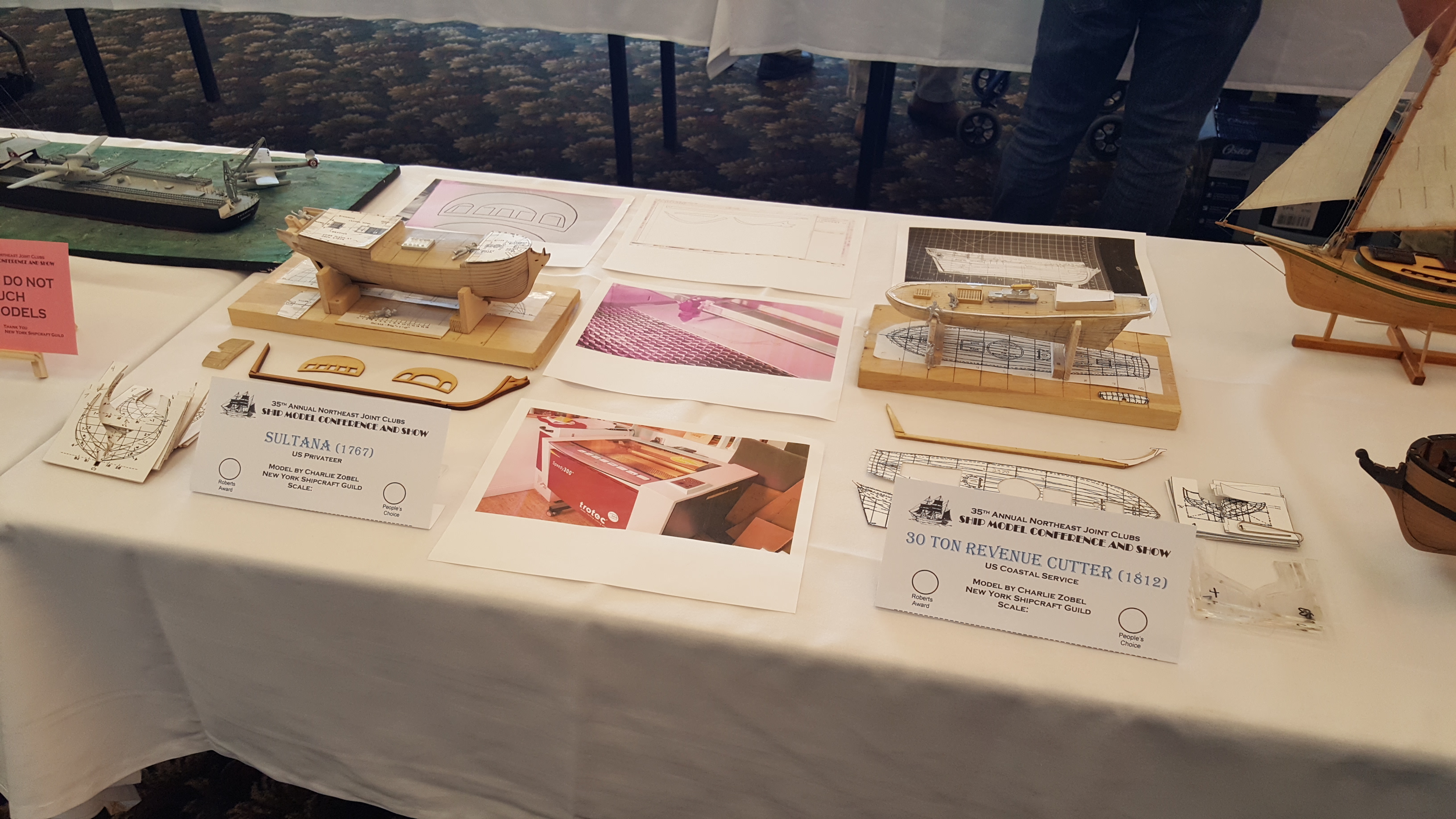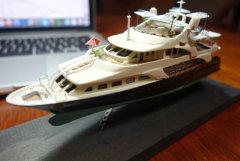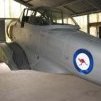MORE HANDBOOKS ARE ON THEIR WAY! We will let you know when they get here.
×
-
Posts
969 -
Joined
-
Last visited
Reputation Activity
-
 CharlieZardoz got a reaction from FriedClams in 19th Century 31-ton Revenue Cutter by CharlieZardoz - Scale 1/64 - building as USRC Active based off Doughty plans and BlueJacket Shipcrafters kit
CharlieZardoz got a reaction from FriedClams in 19th Century 31-ton Revenue Cutter by CharlieZardoz - Scale 1/64 - building as USRC Active based off Doughty plans and BlueJacket Shipcrafters kit
Ill be updating soon and thank you for the kind words same to you and yours as well. For the moment Im doing minor hull corrections for the 30 ton ship as the bow and stern need to be built up a bit (sagging a bit at the ends) then finalizing the shape very minor stuff until the planking arrives. Crown Timbreyard offers offwhite holly strips which I think look more natural as decking material so excited to do my first plank work and learn from it
-
 CharlieZardoz got a reaction from Canute in American sailing warships with no plans or records
CharlieZardoz got a reaction from Canute in American sailing warships with no plans or records
Yeah I imagine it's matter of knowing builders inclinations, taking known dimensions and then knowing what was the fashion of the time and putting it all together. Canney also suggests the plan might also be of Merrimack or at the very least a very similar example which with a bit of imagination could come together as a nice model. Talos I'd love to see the brings lined up, specifically a lot of the ones from 1830 onwards when brigs became less of a staple in the fleet, so Boxer, Perry and Lawrence for examples. I've been looking at those old Bluejacket kits that exist of Boxer and Perry one day I'd like to build those so finding those ships of particular interest at the moment.
So that said I suppose I should ask what were the identifiable traits to a Fox plan or a Humphrey's plan? Or Hackett or Griece? I imagine there is a design evolution that each follow on their own way (of course some of them were specific to the time they lived) but that'd actually be pretty cool to see how the plans from each builder evolved over the years and what each builder brought to style and structure (sleek or bulky lines, more/less traditional). Interesting stuff!
-
 CharlieZardoz got a reaction from mtaylor in American sailing warships with no plans or records
CharlieZardoz got a reaction from mtaylor in American sailing warships with no plans or records
Yeah Talos great help with the explanations and diagrams thank you. Seeing them lined up adds so much perspective. That's what Im thinking though some of the ships (as long as the dimensions and ornamentations have been recorded) could be recreated as reasonably accurate models if one chose to do so since they followed that shrunken 44 design for the most part. Id say replicating Merrimack, Maryland or Patapsco is possible (I forget what info exists for which) (paging sir frolick), but then you have other ships like General Washington or Montezuma where replication is probably impossible unless you are John Millar and have that gift lol. But also if you wanted to lets say use these two plans to build two ship models and give them names according to the aforementioned ships which would work best and why in your opinions?
-
 CharlieZardoz reacted to Talos in American sailing warships with no plans or records
CharlieZardoz reacted to Talos in American sailing warships with no plans or records
Brigs I actually already have you covered. I did two of them, one sheet for the 1830s ships, one for the older ones. The one I'm most fascinated by is the unbuilt USS Burrows, a large, late brig, over 120 feet long. I'll compare some of the frigate body plans later since I can overlay them easily.
-
 CharlieZardoz got a reaction from mtaylor in American sailing warships with no plans or records
CharlieZardoz got a reaction from mtaylor in American sailing warships with no plans or records
Yeah I imagine it's matter of knowing builders inclinations, taking known dimensions and then knowing what was the fashion of the time and putting it all together. Canney also suggests the plan might also be of Merrimack or at the very least a very similar example which with a bit of imagination could come together as a nice model. Talos I'd love to see the brings lined up, specifically a lot of the ones from 1830 onwards when brigs became less of a staple in the fleet, so Boxer, Perry and Lawrence for examples. I've been looking at those old Bluejacket kits that exist of Boxer and Perry one day I'd like to build those so finding those ships of particular interest at the moment.
So that said I suppose I should ask what were the identifiable traits to a Fox plan or a Humphrey's plan? Or Hackett or Griece? I imagine there is a design evolution that each follow on their own way (of course some of them were specific to the time they lived) but that'd actually be pretty cool to see how the plans from each builder evolved over the years and what each builder brought to style and structure (sleek or bulky lines, more/less traditional). Interesting stuff!
-
 CharlieZardoz reacted to Talos in American sailing warships with no plans or records
CharlieZardoz reacted to Talos in American sailing warships with no plans or records
Well, Chapelle was guessing that the 20-gun ship is an improved version of Maryland and Patapsco, soooo..... Merrimack should be pretty easy to do a generic Federal frigate of the era on her dimensions. I'm not sure on the other ships since I have to do some research on them first.
And yeah, I do the diagrams because it adds a lot to me too. Really puts things in perspective and makes it easy to compare. If there's any particular ships through Chapelle's books that you want to see lined up, let me know, I have many of them scanned already.
-
 CharlieZardoz reacted to uss frolick in American sailing warships with no plans or records
CharlieZardoz reacted to uss frolick in American sailing warships with no plans or records
That unidentified 20 ship plan has the look of a reduced Essex, me-thinks, especially about the bow, and the body plan, so I wondered if she might not be the USS Merrimack, 1798, who, I believe, was also built by William Hackett of Salem. Totally subjective observation, of course ...
-
 CharlieZardoz got a reaction from CaptArmstrong in American sailing warships with no plans or records
CharlieZardoz got a reaction from CaptArmstrong in American sailing warships with no plans or records
Hello everyone! I would like to take a quick moment to discuss the unidentified 20 gun ship referenced in Chapelle's book. It is used as an example of what some of the subscription and Contracted sloops of 1798 may have looked like. That said it gets a little confusing to me so would like to defer to the great collective wisdoms of this site for clarity.
So first off we have the 3 ships Merrimack, Maryland and Chesapeake (which was renamed to Patapsco). All were around 24 guns and all seemed to have quarterdecks. Donald Canney and Chapelle seem to point to the plans below as being a similar example to these ships but can't be them because the plans are dated 1799. We then have ships built by private contractors Connecticut, Portsmouth, Warren and Trumbull. The first seem to be 24 gun sloops while the latter are 20 gun. There was also a brig named Richmond. Descriptions of their carvings have been recorded to varying levels of completeness but no plans however we can assume they were of similar ilk.
That's the easy part, next we have a bunch of ships which appear to be purchases. These ships are the General Washington, Montezuma, Ganges, Adriana renamed Baltimore, another renamed Delaware, Herald and two brigs named Norfolk and Augusta. Of these ships it seems that the General Washington was the largest and most impressive. Also many of the others share commonalities to merchant ships and were likely conversions. Chapelle offers a second plan of a through deck sloop with merchant-like qualities of 18 guns which based on dimensions and design I am assuming could represent what some of these ships looked like.
All these ships were essentially replaced in 1801 when the superior(?) Federal and subscription frigates were put into service.
This period is fascinating since so little is known about it (much less than even the subscription era that came afterwards). So let's say one wanted to build a model based off these two plans or of some of these aforementioned sloop (mini-frigates?) how would one go about it? By this I mean lets say I wanted to build Merrimack, Patapsco or Maryland one day using the figure 22 plans as a guide is there enough info to do so? Same with figure 23 could any of the merchant ships look most like that one if any? Could the Warren or Trumbull which had no quarterdeck be examples of such a ship. This is of course all conjectural I'm trying to determine what ships have a decent amount of information preserved vs those which have none. So lets discuss
-
 CharlieZardoz got a reaction from Talos in American sailing warships with no plans or records
CharlieZardoz got a reaction from Talos in American sailing warships with no plans or records
Yeah Talos great help with the explanations and diagrams thank you. Seeing them lined up adds so much perspective. That's what Im thinking though some of the ships (as long as the dimensions and ornamentations have been recorded) could be recreated as reasonably accurate models if one chose to do so since they followed that shrunken 44 design for the most part. Id say replicating Merrimack, Maryland or Patapsco is possible (I forget what info exists for which) (paging sir frolick), but then you have other ships like General Washington or Montezuma where replication is probably impossible unless you are John Millar and have that gift lol. But also if you wanted to lets say use these two plans to build two ship models and give them names according to the aforementioned ships which would work best and why in your opinions?
-
 CharlieZardoz got a reaction from Talos in American sailing warships with no plans or records
CharlieZardoz got a reaction from Talos in American sailing warships with no plans or records
Hello everyone! I would like to take a quick moment to discuss the unidentified 20 gun ship referenced in Chapelle's book. It is used as an example of what some of the subscription and Contracted sloops of 1798 may have looked like. That said it gets a little confusing to me so would like to defer to the great collective wisdoms of this site for clarity.
So first off we have the 3 ships Merrimack, Maryland and Chesapeake (which was renamed to Patapsco). All were around 24 guns and all seemed to have quarterdecks. Donald Canney and Chapelle seem to point to the plans below as being a similar example to these ships but can't be them because the plans are dated 1799. We then have ships built by private contractors Connecticut, Portsmouth, Warren and Trumbull. The first seem to be 24 gun sloops while the latter are 20 gun. There was also a brig named Richmond. Descriptions of their carvings have been recorded to varying levels of completeness but no plans however we can assume they were of similar ilk.
That's the easy part, next we have a bunch of ships which appear to be purchases. These ships are the General Washington, Montezuma, Ganges, Adriana renamed Baltimore, another renamed Delaware, Herald and two brigs named Norfolk and Augusta. Of these ships it seems that the General Washington was the largest and most impressive. Also many of the others share commonalities to merchant ships and were likely conversions. Chapelle offers a second plan of a through deck sloop with merchant-like qualities of 18 guns which based on dimensions and design I am assuming could represent what some of these ships looked like.
All these ships were essentially replaced in 1801 when the superior(?) Federal and subscription frigates were put into service.
This period is fascinating since so little is known about it (much less than even the subscription era that came afterwards). So let's say one wanted to build a model based off these two plans or of some of these aforementioned sloop (mini-frigates?) how would one go about it? By this I mean lets say I wanted to build Merrimack, Patapsco or Maryland one day using the figure 22 plans as a guide is there enough info to do so? Same with figure 23 could any of the merchant ships look most like that one if any? Could the Warren or Trumbull which had no quarterdeck be examples of such a ship. This is of course all conjectural I'm trying to determine what ships have a decent amount of information preserved vs those which have none. So lets discuss
-
 CharlieZardoz got a reaction from uss frolick in American sailing warships with no plans or records
CharlieZardoz got a reaction from uss frolick in American sailing warships with no plans or records
Yeah Talos great help with the explanations and diagrams thank you. Seeing them lined up adds so much perspective. That's what Im thinking though some of the ships (as long as the dimensions and ornamentations have been recorded) could be recreated as reasonably accurate models if one chose to do so since they followed that shrunken 44 design for the most part. Id say replicating Merrimack, Maryland or Patapsco is possible (I forget what info exists for which) (paging sir frolick), but then you have other ships like General Washington or Montezuma where replication is probably impossible unless you are John Millar and have that gift lol. But also if you wanted to lets say use these two plans to build two ship models and give them names according to the aforementioned ships which would work best and why in your opinions?
-
 CharlieZardoz got a reaction from Canute in American sailing warships with no plans or records
CharlieZardoz got a reaction from Canute in American sailing warships with no plans or records
Yeah Talos great help with the explanations and diagrams thank you. Seeing them lined up adds so much perspective. That's what Im thinking though some of the ships (as long as the dimensions and ornamentations have been recorded) could be recreated as reasonably accurate models if one chose to do so since they followed that shrunken 44 design for the most part. Id say replicating Merrimack, Maryland or Patapsco is possible (I forget what info exists for which) (paging sir frolick), but then you have other ships like General Washington or Montezuma where replication is probably impossible unless you are John Millar and have that gift lol. But also if you wanted to lets say use these two plans to build two ship models and give them names according to the aforementioned ships which would work best and why in your opinions?
-
 CharlieZardoz got a reaction from Omega1234 in 19th Century 31-ton Revenue Cutter by CharlieZardoz - Scale 1/64 - building as USRC Active based off Doughty plans and BlueJacket Shipcrafters kit
CharlieZardoz got a reaction from Omega1234 in 19th Century 31-ton Revenue Cutter by CharlieZardoz - Scale 1/64 - building as USRC Active based off Doughty plans and BlueJacket Shipcrafters kit
Ill be updating soon and thank you for the kind words same to you and yours as well. For the moment Im doing minor hull corrections for the 30 ton ship as the bow and stern need to be built up a bit (sagging a bit at the ends) then finalizing the shape very minor stuff until the planking arrives. Crown Timbreyard offers offwhite holly strips which I think look more natural as decking material so excited to do my first plank work and learn from it
-
 CharlieZardoz got a reaction from DocBlake in 19th Century 31-ton Revenue Cutter by CharlieZardoz - Scale 1/64 - building as USRC Active based off Doughty plans and BlueJacket Shipcrafters kit
CharlieZardoz got a reaction from DocBlake in 19th Century 31-ton Revenue Cutter by CharlieZardoz - Scale 1/64 - building as USRC Active based off Doughty plans and BlueJacket Shipcrafters kit
Greetings everyone! Will make a ship model update soon. Basically last few weeks have been difficult ones as our 4 cats got ill suddenly all started vomiting stopped eating an drinking. Antibiotics cured them however my oldest boy of 19 was too frail and weak to recover and passed shortly in his kitty bed. Then after that one of my closest friends was hit by a car and has sustained significant injuries. Keeping positive and will be getting back to work (waiting on my Crown Timbreyard wood anyhow) and just trying to make it through the holiday season... :/
-
 CharlieZardoz reacted to Talos in American sailing warships with no plans or records
CharlieZardoz reacted to Talos in American sailing warships with no plans or records
I’ve been fascinated with those two particular plans for a while. I included them in one of my profile comparisons, alongside the privateer Rattlesnake and the (incorrect!) Cyane.
The 18-gun one is just so weird, compared to the warships I’m used to seeing. More merchant-like for sure, but still too sharp to be a civilian one, too big for an illegal trader. Chapelle argues that she must be a naval or merchant-cruiser. He also suggests that it was a design by Fox because of the nature of her stem.
As far as the 20, it’s got the appearance of the typical American frigates of the era. Looking at the plans of John Adams and this ship, they’re virtually identical above the waterline except for size. Chapelle suggests that it was a design for an improved version of Maryland and Patapsco, nearly identical dimensions but with fewer guns and higher gunports to correct the guns on the earlier ships being very low. He also compares the ship to the Brazen-class Cyane post ship, which had more guns on the main deck, but 6pdrs instead of 9pdrs, and was the better sailor because it wasn't as overloaded until the War of 1812 when it carried 32 guns instead. I’ve pointed it out before, but I will again, but Chapelle got the wrong Cyane plans when he sent for them. The ones in the book are the older 18-gun Bittern-class sloop Cyane, not the 26-gun Brazen-class Cyane the Americans captured. Thinking it was the War of 1812 ship, he refitted the drawing with solid bulwarks like most ships of the era received. That’s the plan I have in the comparison I’m linking.
As far as the other ships go, Chapelle points out that everything in this era down to sloops tended to be shrunken versions of the 44s, at least above-water style-wise. You can see that comparing John Adams and the 20-gun ship. As long as you get the proportions and dimensions right, you can probably do a fair amount basing off of the 20-gun, Constitution/Constellation/Chesapeake, and the Philly, New York, Boston, and Essex.
-
 CharlieZardoz got a reaction from PeteB in 19th Century 31-ton Revenue Cutter by CharlieZardoz - Scale 1/64 - building as USRC Active based off Doughty plans and BlueJacket Shipcrafters kit
CharlieZardoz got a reaction from PeteB in 19th Century 31-ton Revenue Cutter by CharlieZardoz - Scale 1/64 - building as USRC Active based off Doughty plans and BlueJacket Shipcrafters kit
Hey guys! Well I did a bit more research to try and understand the nature of the planking of this type of ship and from what I see the model kits follow the graduated method. I spoke with Cathead regarding his Corel Ranger build and said the planks came in 3-4mm strips while Dallas has 5mm strips. But it's more than that he also said that the planks closest to the wales are thinner 3mm while the ones closer to the keel are 4mm. Look at the collage I posted of Dirk's gorgeous model and you can see how he laid out the planks (the scarfs were later covered by the wale) with thinner planks towards the deck. That said I feel that the krick model overdoes it with the thinness of planks they would probably be like 5" wide in real life. Look at the image of the cutter I posted and added 1/8" notches where planking would go. They seem a bit too big (these would be 8" planks in real life), so I think for this model having the average plank size of 7" (7/64") should be sufficient with the larger two models increasing to 1/8" (8" planks) and then 9/64" (9" planks) all having a few larger and smaller planks where needed. The decks will all be 9/64" no change there. That's the plan anyways well see what happens
So here is what I am going to do. I already have a stash of veneer cherry at 1/8" on hand which will be used for the widest planks in the center and towards the stern, then Ill order a bunch that are 7/64" in for the main planking and last a few at 3/32" for those closest to the deck curve. See Allan you are of course correct the answer is spilling. It's always spilling and in the future when I have a Byrnes table saw of my own I will no doubt work using that method but for now with these simple models I think having a couple of plank sizes and then curving/tapering the larger ones to fit is a stepping stone to spilling for me. I also plan on doing this for Sultana and this model(s) is already helping me understand how they will interrelate. It's having an inventory of plank sizes and using what is needed which in turn makes the idea of eventually milling my own very appealing! The idea of doing this on some major model like Confederacy seems like a distant dream at this point, I think I've developed a bit of planking phobia lol
-
 CharlieZardoz reacted to Cathead in 19th Century 31-ton Revenue Cutter by CharlieZardoz - Scale 1/64 - building as USRC Active based off Doughty plans and BlueJacket Shipcrafters kit
CharlieZardoz reacted to Cathead in 19th Century 31-ton Revenue Cutter by CharlieZardoz - Scale 1/64 - building as USRC Active based off Doughty plans and BlueJacket Shipcrafters kit
I'll "like" it as a gesture of respect for the bonds you felt and feel with those important to you. As an obvious cat lover myself, I empathize with your loss. Best wishes to your friend as well; over a decade ago I worked to recover from a serious neck injury that might have changed my life (well, it still did even though I fully recovered).
Merry Christmas or Solstice or whatever else floats your boat (as farmers and land managers, we're partial to the solstice ourselves). I'm looking forward to reading more about your ambitious project whenever life allows you to get back to it.
-
 CharlieZardoz got a reaction from Cathead in 19th Century 31-ton Revenue Cutter by CharlieZardoz - Scale 1/64 - building as USRC Active based off Doughty plans and BlueJacket Shipcrafters kit
CharlieZardoz got a reaction from Cathead in 19th Century 31-ton Revenue Cutter by CharlieZardoz - Scale 1/64 - building as USRC Active based off Doughty plans and BlueJacket Shipcrafters kit
Greetings everyone! Will make a ship model update soon. Basically last few weeks have been difficult ones as our 4 cats got ill suddenly all started vomiting stopped eating an drinking. Antibiotics cured them however my oldest boy of 19 was too frail and weak to recover and passed shortly in his kitty bed. Then after that one of my closest friends was hit by a car and has sustained significant injuries. Keeping positive and will be getting back to work (waiting on my Crown Timbreyard wood anyhow) and just trying to make it through the holiday season... :/
-
 CharlieZardoz reacted to mtaylor in Licorne 1755 by mtaylor - 3/16" scale - French Frigate - from Hahn plans - Version 2.0 - TERMINATED
CharlieZardoz reacted to mtaylor in Licorne 1755 by mtaylor - 3/16" scale - French Frigate - from Hahn plans - Version 2.0 - TERMINATED
Been a bit since the last update. Thanks for following along on this journey of discovery and sawdust and for the likes and the comments.
A bit of a minor/major milestone... the ship is in the cradle... YIPPEE!!!!!
The next step is start removing the build board and trimming down the frames to the sheer strake(s).
I considered pedestals versus a cradle as I didn't want to stress the keel, etc .nor did I want to attempt to put a large baseboard on at this point. The cradle just seems (to me) to be steadier and stronger. I noted that I do seem to get some wobble on my Constellation which is on pedestals. It could be my method of mounting is faulty or just the way it is with them.
The cradle is 1/4" mahogany (see photo). After finessing it into position, assembling it and re-finessing, I drilled a 3/32" hole through the cradle and inserted a brass tube of the appropriate diameter. I mounted the cradle into position, and drilled (using the tubing as a drill guide) a 1/16" hole through the keel, frames and keelson. A brass rod was inserted with a light coating of epoxy. When set, the cradles were set into place with more epoxy on the brass rod and in two places on each end of the cradle. The structure seems sound and steady.
I tried to design the cradle so as not to hide the lines of her and I think I pretty much succeeded. At some point, the hole where the crosspieces go through the cradle will be covered by a small carving on each. I'm leaning towards a fleur de lis.
Anyway, here's the pictures.
-
 CharlieZardoz got a reaction from uss frolick in American sailing warships with no plans or records
CharlieZardoz got a reaction from uss frolick in American sailing warships with no plans or records
Hello everyone! I would like to take a quick moment to discuss the unidentified 20 gun ship referenced in Chapelle's book. It is used as an example of what some of the subscription and Contracted sloops of 1798 may have looked like. That said it gets a little confusing to me so would like to defer to the great collective wisdoms of this site for clarity.
So first off we have the 3 ships Merrimack, Maryland and Chesapeake (which was renamed to Patapsco). All were around 24 guns and all seemed to have quarterdecks. Donald Canney and Chapelle seem to point to the plans below as being a similar example to these ships but can't be them because the plans are dated 1799. We then have ships built by private contractors Connecticut, Portsmouth, Warren and Trumbull. The first seem to be 24 gun sloops while the latter are 20 gun. There was also a brig named Richmond. Descriptions of their carvings have been recorded to varying levels of completeness but no plans however we can assume they were of similar ilk.
That's the easy part, next we have a bunch of ships which appear to be purchases. These ships are the General Washington, Montezuma, Ganges, Adriana renamed Baltimore, another renamed Delaware, Herald and two brigs named Norfolk and Augusta. Of these ships it seems that the General Washington was the largest and most impressive. Also many of the others share commonalities to merchant ships and were likely conversions. Chapelle offers a second plan of a through deck sloop with merchant-like qualities of 18 guns which based on dimensions and design I am assuming could represent what some of these ships looked like.
All these ships were essentially replaced in 1801 when the superior(?) Federal and subscription frigates were put into service.
This period is fascinating since so little is known about it (much less than even the subscription era that came afterwards). So let's say one wanted to build a model based off these two plans or of some of these aforementioned sloop (mini-frigates?) how would one go about it? By this I mean lets say I wanted to build Merrimack, Patapsco or Maryland one day using the figure 22 plans as a guide is there enough info to do so? Same with figure 23 could any of the merchant ships look most like that one if any? Could the Warren or Trumbull which had no quarterdeck be examples of such a ship. This is of course all conjectural I'm trying to determine what ships have a decent amount of information preserved vs those which have none. So lets discuss
-
 CharlieZardoz got a reaction from Landlubber Mike in 19th Century 31-ton Revenue Cutter by CharlieZardoz - Scale 1/64 - building as USRC Active based off Doughty plans and BlueJacket Shipcrafters kit
CharlieZardoz got a reaction from Landlubber Mike in 19th Century 31-ton Revenue Cutter by CharlieZardoz - Scale 1/64 - building as USRC Active based off Doughty plans and BlueJacket Shipcrafters kit
Thanks Mark! So far so good he's out of ICU but he has a lot of recovering to do. It's been quite a crazy year for sure.
-
 CharlieZardoz reacted to mtaylor in 19th Century 31-ton Revenue Cutter by CharlieZardoz - Scale 1/64 - building as USRC Active based off Doughty plans and BlueJacket Shipcrafters kit
CharlieZardoz reacted to mtaylor in 19th Century 31-ton Revenue Cutter by CharlieZardoz - Scale 1/64 - building as USRC Active based off Doughty plans and BlueJacket Shipcrafters kit
I don't want to "like" this. Sorry about cat and friend. Those things aren't good no matter what time of year. I hope your friend has a full and complete recovery.
-
 CharlieZardoz reacted to Aa-schipper in HMS Mars 1781 by Aa-schipper - Caldercraft - Scale 1:64 - Dutch privateer
CharlieZardoz reacted to Aa-schipper in HMS Mars 1781 by Aa-schipper - Caldercraft - Scale 1:64 - Dutch privateer
Caldercraft is supposed to be one of the best quality brands around. So I have on my table one of the best kits! My ambition is to make out of this 3 kg bundle of different kinds of wood, the bag full of fittings, the brass details and other small elements the Dutch brig Mars.
The “H.M.S. Mars” kit was made after plans of the H.M.S. Orestes, a British Royal Navy brig that began its life as a Dutch privateer called Mars. In fact, as others have noted, there never was an “H.M.S. Mars”. Being a Dutchman myself, I’d like to rewrite history a little, or recreate history: what did the ship look like that was lost in the encounter with the frigate H.M.S. Artois on 3 December 1781?
In the process, I hope to find out a lot more about the Mars, its sister ship Hercules, and about Dutch privateering in the fourth Anglo-Dutch war. The focus will be, of course, on the model itself: what did the Mars look like just before 3 December 1781? What were her colours, how was the rigging, with what cannons was she fitted out, etc.?
Count on this becoming a ten-year plan… I’m not in a hurry, and I am quite busy with my job (an office job, not related with wood-working at all), with other hobbies (photography among them—build pictures will be better than the one included in this post) and sports (on land, I'm not a sailor), so I’ll work on this project on and off, not in a continuous fashion.
As for my model building experience: after having built a number of plastic kits when I was in my teens (Airfix models of Victory, Wasa, and Cutty Sark), I picked up ship models a couple of decades later when I visited the reconstructed VOC return ship Batavia in Lelystad and found there was a (plastic again) model available. After completing that one, I turned to wooden models and first tried my skills on the Sperwer by Billing Boats. There is a picture of my Sperwer in the completed builds gallery. And now there is the kit that has to become the Mars…
On opening the box, others have commented about the quality of the wooden parts, etc. I am not so skilled that I could comment on their quality — it all looks pretty solid to me! I expect to use what is available in the kit, though I’ll be willing to try making adjustments and do some building from scratch to get closer to the historical Mars. I did notice, though, that the booklet with building instructions is not very long or detailed, but I hope that the seven large sheets with drawings will make up for that. Besides, there is the literature. On my bookshelf there are, amongst others:
· Julier, Keith. (2004). The New Period Ship Handbook. Poole, Dorset (UK): Special Interest Model Books. [With a chapter on building H.M.S. Mars]
· Dressel, Donald. (1988). Planking Techniques for Model Ship Builders. New York etc.: TAB Books. [Planking Sperwer I found the most difficult part; it took me a lot of time to admit having made errors there, but I finished the single-planked model nevertheless.]
· Petersson, Lennarth. (2000). Rigging Period Ship Models. London: Chatham Publishing. [based on a 1785 British frigate: the correct period for Mars]
· Petrejus, E.W. (1974). Nederlandse zeilschepen in de negentiende eeuw. [Dutch sailing ships in the nineteenth century]. Bussum: Unieboek. [Petrejus related that Dutch rigging in the early 1800's differed from the British way of doing it.]
And finally, I hope I can benefit from the experiences of all you great folks at this forum.
To translate a fitting Dutch proverb literally: We’ll see where this ship runs aground…
-
 CharlieZardoz reacted to GuntherMT in How much detail is too much
CharlieZardoz reacted to GuntherMT in How much detail is too much
Holy crap. Spend the time to look at that Royal Caroline. It has crazy stuff like this:
-
 CharlieZardoz reacted to uss frolick in How much detail is too much
CharlieZardoz reacted to uss frolick in How much detail is too much
Frolick: "My darling, is it possible for my precious wife to be too beautiful?"
Mrs Frolick, applying lipstick : "Yes. You still have to clean out the garage."











